|
|
|
|
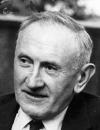
 Fritz Zwicky (1898-1974), whose 100'th birthday would have been celebrated in 1998,
is considered both as one of the most brilliant astrophysisist
as well as one of the most unusual personalities in the 20'th century.
The Swiss citizen Zwicky was born the 14'th of February
1898 in Varna
in Bulgary and grew up in
Mollis im
a Swiss village in the Canton of Glarus . (A 'Canton' in Switzerland is the equivalent
of a 'state' in the United States).
Fritz Zwicky (1898-1974), whose 100'th birthday would have been celebrated in 1998,
is considered both as one of the most brilliant astrophysisist
as well as one of the most unusual personalities in the 20'th century.
The Swiss citizen Zwicky was born the 14'th of February
1898 in Varna
in Bulgary and grew up in
Mollis im
a Swiss village in the Canton of Glarus . (A 'Canton' in Switzerland is the equivalent
of a 'state' in the United States).
|
Zwicki's study years at the
ETH in Zürich
are characterized by an admiration for genius teachers.
At the end of his studies in the field of physics he wrote his
diploma thesis (this corresponds to a "honors theses" at US
universities but is mandatory and often serious research),
under the guidance of the Mathematician
 Herman Weyl (1885-1955) .
During his studies at the ETH, Zwicky was particularly impressed by his
physics teacher
Auguste Piccard (1884-1962) .
After a dissertation in the year 1922 under the guidance of the later
chemistry Nobel prize winner (1936) )
Herman Weyl (1885-1955) .
During his studies at the ETH, Zwicky was particularly impressed by his
physics teacher
Auguste Piccard (1884-1962) .
After a dissertation in the year 1922 under the guidance of the later
chemistry Nobel prize winner (1936) )
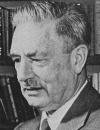 Peter Debye (1884-1966) and correferee Paul Scherrer (1890-1969)
(the confounder of the Cern), he was taken to
Caltech
by Millikan.
Zwicky would stay for a long time at Caltech. He had also regular
contacts with
Albert Einstein. This, as well as the fact that Einstein was
teaching at the ETH, while Zwicky was studying there, were the reasons
that he was sometimes introduced as a "student of Einstein" in the USA.
Zwicky's weakness for geniuses becomes evident especially in his book
"Everybody a genius". This title is in contrast to the
Dilbert's principle: "We are all idiots".
But the reader of the book will be amused to find it more or less
a predecessor of the Dilbert principle.
Peter Debye (1884-1966) and correferee Paul Scherrer (1890-1969)
(the confounder of the Cern), he was taken to
Caltech
by Millikan.
Zwicky would stay for a long time at Caltech. He had also regular
contacts with
Albert Einstein. This, as well as the fact that Einstein was
teaching at the ETH, while Zwicky was studying there, were the reasons
that he was sometimes introduced as a "student of Einstein" in the USA.
Zwicky's weakness for geniuses becomes evident especially in his book
"Everybody a genius". This title is in contrast to the
Dilbert's principle: "We are all idiots".
But the reader of the book will be amused to find it more or less
a predecessor of the Dilbert principle.
|
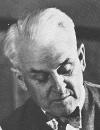 Zwicky has been called to Caltech in 1925 by Millikan
Zwicky has been called to Caltech in 1925 by Millikan
 Millikan, (1868-1953) who got in 1923 the nobel prize for his work on the
electric elementary charge with the
(
Millikan
oil experiment ) expected from Zwicky first rank theoretical
research in the topic of quantum mechanics of atoms and metals.
During the 20ies and 30ies, Zwicky got attracted more and more
by astrophysics. According to one of the many annectotes told
about Zwicky, there is the story that Zwicky had accused
Millikan that he, (Millikan) never ever had a good idea.
Millikan reportedly had replied: "Well, good, young man, and
what about you?" Zwicky: "I have a good idea every two years.
Give me a topic, I will give you the idea!".
Hereafter, Millikan should have asked Zwicky spontaneously to try it in
astrophysics (source: Wild). Indeed, Caltech needed astrophysists at
that time because it was busy building the Mount Palomar observatory.
Millikan, (1868-1953) who got in 1923 the nobel prize for his work on the
electric elementary charge with the
(
Millikan
oil experiment ) expected from Zwicky first rank theoretical
research in the topic of quantum mechanics of atoms and metals.
During the 20ies and 30ies, Zwicky got attracted more and more
by astrophysics. According to one of the many annectotes told
about Zwicky, there is the story that Zwicky had accused
Millikan that he, (Millikan) never ever had a good idea.
Millikan reportedly had replied: "Well, good, young man, and
what about you?" Zwicky: "I have a good idea every two years.
Give me a topic, I will give you the idea!".
Hereafter, Millikan should have asked Zwicky spontaneously to try it in
astrophysics (source: Wild). Indeed, Caltech needed astrophysists at
that time because it was busy building the Mount Palomar observatory.
|
 During the thirties and forties, many of Zwicky's colleagues
thought of Zwicky as a "big mouth", but later generations of astrophysisics
should think of him as a creative genius (Thorne). Aversions against
Zwicky's habit, "to call the child by the name" and to consider
"humbleness as a lie" survive until now. In the history of
the Wilson observatory or
many textbook in astronomy, one looks in vain for the names Zwicky or Baade.
One of the reasons might be that the rather stubborn Zwicky kept his
Swiss citizenship at all times, evenso he had lived for more than 40 years
in the US. (Source Wild).
During the thirties and forties, many of Zwicky's colleagues
thought of Zwicky as a "big mouth", but later generations of astrophysisics
should think of him as a creative genius (Thorne). Aversions against
Zwicky's habit, "to call the child by the name" and to consider
"humbleness as a lie" survive until now. In the history of
the Wilson observatory or
many textbook in astronomy, one looks in vain for the names Zwicky or Baade.
One of the reasons might be that the rather stubborn Zwicky kept his
Swiss citizenship at all times, evenso he had lived for more than 40 years
in the US. (Source Wild).
|
| From the campus of the California Institute of Technology (Caltech) in Pasadena one can see at good weather and clear view the Mount Wilson . On this mountain near Pasadena, Caltech maintains until this day an observatory. From Pasadena, one can drive by car in a half an hour to the top of the mountain. This beautiful mountain road is called the Crest Highway. It passes through a place which forms in the summer a cool oasis in the north of the dry Mojave desert and to the south of the Los Angeles metropolis. Coming from Glarus in Switzerland which has plenty of mountains, Zwicky liked this place in the Californian St Gabriel mountains not only to work. As a passionate climber, he liked the mountains. In the winter, he often would take his skies to his work place in order to jump on a self built ramp near the telescope. |

From the scientific point of view, the Mount Wilson is an
important place:
|
Many annectotes exist about Zwicky:
|
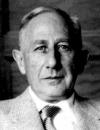 Walter Baade (1893-1960) was a German astronomer who came at the
beginning of the thirties from Hamburg and Göttingen to Pasadena
in order to make observations at the Mount Wilson observatory.
Baade was a brilliant astronomer with an Enzyklopedic knowledge.
His character was rather the opposite of the stormy Zwicky.
The antipodes Zwicky and Baade attracted each
other however soon, each recognizing the qualities of the other.
One has seen in these years Zwicky and Baade often in Pasadena to talk
in an animated way about "Novae". Novae are newly appearing stars, which
can suddenly become 10000 times stronger as before and whose
brightness then return to a normal value in about a month. There were
indications about exceptionally bright Novae which appeared in certain
nebulae. During the 20'th, astrophysicists began to suspect that these
nebulae were not gas nebulae from the milky way but galaxies themselves,
immense accumulations of billions of stars.
According to Baade's calculations, such novae would be million times
stronger than the sun.
Walter Baade (1893-1960) was a German astronomer who came at the
beginning of the thirties from Hamburg and Göttingen to Pasadena
in order to make observations at the Mount Wilson observatory.
Baade was a brilliant astronomer with an Enzyklopedic knowledge.
His character was rather the opposite of the stormy Zwicky.
The antipodes Zwicky and Baade attracted each
other however soon, each recognizing the qualities of the other.
One has seen in these years Zwicky and Baade often in Pasadena to talk
in an animated way about "Novae". Novae are newly appearing stars, which
can suddenly become 10000 times stronger as before and whose
brightness then return to a normal value in about a month. There were
indications about exceptionally bright Novae which appeared in certain
nebulae. During the 20'th, astrophysicists began to suspect that these
nebulae were not gas nebulae from the milky way but galaxies themselves,
immense accumulations of billions of stars.
According to Baade's calculations, such novae would be million times
stronger than the sun.
|
| With his attraction for the extreme, Zwicky was fascinated by Novae. Together with Baade, he called the phenomenon "Supernovae". They predicted that these Supernovae would be created by explosions of normal stars. To explain this, Zwicky invented the neutron star. By accident, the neutron just has been found at the time, when Zwicky and Baade were working on the explanation of Supernovae. The neutron was exactly, what Zwicky needed. Maybe, a normal star could implode until it reaches the density of a nucleus? Zwicky called the corresponding neutron gas a "neutron star". The released energy from the implosion would give the explosive energy and would be enough to explain the Supernovae. At this time, one was also beginning to find the origin of the cosmic Gamma ray radiation with which the earth is bombarded from space. Millikan was an expert in this field. Zwicky convinced himself that most of this cosmic radiation would come from Supernovae. In the year 1934, Zwicky and Baade presented their work "Supernovae and Cosmic Rays" in Stanford. It is considered as one of the far reaching works in the history of physics and astronomy. (citing Thorne). |
|
The story about the discovery of neutron stars is exemplary. Today,
60 years after finding neutron stars, astrophysicists still look for
and find new kind of stars. In may 1998, such an event happened, when
magnetars were discovered.
Magnetars are neutronstars with the strongest magnetic fields known.
These stars were theoretically predicted in 1992 by
Duncan and Thomson
Observations from this year confirm now this theory, even so the
experts have for a long time laughted about such ideas.
Fritz Zwicky mentioned in the year 1933, that rich galaxies have 10 to 100 times the visible mass in order that they can be hold together . The reason for this dark matter is still today a mystery. |
Zwicky developed phantastic science fiction ideas which do not stand
back to some ideas of Jules Vernes.
|
|
"Morphology" is a method of thinking which has been introduced by
Zwicky. One of the ideas of morphology is to systematically search
for a solution of a problem by trying out all combinations in a
matrix of expressions. The matrix is called a
'morphologic box'. The fact that the search will also reveal unusual
or even crazy combinations, is one of the basic ingredients of creativity.
In the case of chess for example it was a surprise that a mostly
computerized search of good solutions can lead to creative chess play.
This went so far that
Garry Kasparov accused the team behind the computer
Deep Blue
of fraud after a lost game. Zwicky has used the morphologie in his research as well as in the industry as a consultant to the company "Aerojet". As an illustration who Zwicky might have come to ideas, the reader can try the method him/herself. Find all combinations in the following matrix:
Trying all combinations leads to crazy ideas like for example a new kind of space travel, where the sun is used as a rocket or the idea to shoot onto the moon or the idea to build shoot through the earth for travel reasons. These three ideas actually have been proposed by Zwicky. Morphology has been popular in management for some time. for example at the Ciba (Now innovag) . The method has however also disadvantages and can be too slow. A story illustrating this as well as a critics of Bruno Stanek can be found in Müller's book on Zwicky. |
 In the Zwicky biographie of Müller is asked the question
weather it has been Lenin,
who has been living in Zürich door to door with Zwicky
at the Spiegelgasse, who has given the initial idea of Morphology to Zwicky.
According to Zwicky's friend Albert Wilson, there was a climate of
tolerance in Zürich at the beginning of the 20'th century
which has allowed to grow new ideas. Examples like Lenin, Einstein,
C.G. Jung , Trotsky or Zwicky should prove this.
(source Müller). Whether Lenin had any influence on Zwicky is
doubtful because Zwicky has been a firm anti-communist as a student
even to leave his studies for some time to work as a political
secretary in one of himself founded organization to fight the
'communistic agitators'.
Zwicky's teachers at the Poly (jargon for the
ETH Zürich )
were probably more important for his later reflections about thinking.
Zwicky has heard lectures from outstanding Mathematicians like
Weyl, Grossmann, Polya or Hurwitz. Polya shows in his famous booklet
on "solving mathematical problems" that one has thought at the ETH
about the mechanisms of creativity.
In the Zwicky biographie of Müller is asked the question
weather it has been Lenin,
who has been living in Zürich door to door with Zwicky
at the Spiegelgasse, who has given the initial idea of Morphology to Zwicky.
According to Zwicky's friend Albert Wilson, there was a climate of
tolerance in Zürich at the beginning of the 20'th century
which has allowed to grow new ideas. Examples like Lenin, Einstein,
C.G. Jung , Trotsky or Zwicky should prove this.
(source Müller). Whether Lenin had any influence on Zwicky is
doubtful because Zwicky has been a firm anti-communist as a student
even to leave his studies for some time to work as a political
secretary in one of himself founded organization to fight the
'communistic agitators'.
Zwicky's teachers at the Poly (jargon for the
ETH Zürich )
were probably more important for his later reflections about thinking.
Zwicky has heard lectures from outstanding Mathematicians like
Weyl, Grossmann, Polya or Hurwitz. Polya shows in his famous booklet
on "solving mathematical problems" that one has thought at the ETH
about the mechanisms of creativity.
|
|
Besides his work at Caltech, Zwicky was also working in the
Californian rocket factory 'Aerojet'. According to
Reichstein, this second engagement was a welcome opportunity for
Zwicky to disappear from Campus, in case the air should get there
"too thick". Zwicky was proud of having contributed essentially to the 1957 shot of the first human bullet into space, an object manufactured on earth which should leave the gravity of earth for ever. These experiments were done with German V2 rockets, which when reaching the highest point would shoot a bullet away. These experiments with 'artificial meteors' have begun shortly after world war II and were first unsuccessful. When it finally worked 10 years later, they were shadowed by far more important developments: Sputnik had been launched into an earth orbit. The aftershock of this event produced an intense research activity in the US, from which Zwicky has been completely rolled over. He seems to have minded quite a bit that the later developments in astronautics have been achieved without him. An indication of this is that the first step of humans on the moon have not even been mentioned in the diaries of Zwicky. |

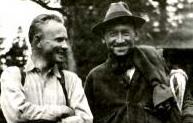 Having been grown up the mountains of Glarus, Zwicky got acquainted
in a natural way to mountain climbing. Also during his study times at the ETH
he went with his fried Thadeus Reichstein (1897-1996) to the mountains.
(Reichstein should later get the Nobel prize in Medicine
together with Philip S. Hench and Edward C. Kendall about the
discovery of the Cortisone.
Reichstein
has also first synthesized
the vitamins C and like this led the foundations for an industrial
production of this Vitamin.)
Having been grown up the mountains of Glarus, Zwicky got acquainted
in a natural way to mountain climbing. Also during his study times at the ETH
he went with his fried Thadeus Reichstein (1897-1996) to the mountains.
(Reichstein should later get the Nobel prize in Medicine
together with Philip S. Hench and Edward C. Kendall about the
discovery of the Cortisone.
Reichstein
has also first synthesized
the vitamins C and like this led the foundations for an industrial
production of this Vitamin.) The mountain-team Reichstein-Zwicky has o opened some new climbing routes in the Alps. Some of them have entered the club guides of the Swiss Alp club (SAC). In the year 1924 for example, the duo was climbing the "Glärnisch Nordwand". When Zwicky got in 1925 the Rockefeller fellowship to pursue his postdoctoral studies in the US he chose the Caltech in Pasadena. It is told that he should have given as the reason for this choice: "because there are mountains there". Some reasoning of Zwicky about the question why people go climbing shows some originality and (typically Zwicky) does not hide the awareness of its originality.
|
 During decades, Zwicky has kept correspondence with
Rösli Streiff (the
world champion in Slalom skiing in 1932.)
Some of the letters are reproduced in Müller's biographie.
They tell a lot about the life and the thinking of Zwicky during
that time. The correspondence with Streiff unfortunately ends
in 1947, when Zwicky married the second time.
During decades, Zwicky has kept correspondence with
Rösli Streiff (the
world champion in Slalom skiing in 1932.)
Some of the letters are reproduced in Müller's biographie.
They tell a lot about the life and the thinking of Zwicky during
that time. The correspondence with Streiff unfortunately ends
in 1947, when Zwicky married the second time. A section from one of the last letters to Streiff indicates a for Zwicky stressful time in 1946, while Zwicky was still living divorced:
Zwicky met his second wife in the spring of 1947 in Thun (Switzerland). Also after his retirement in the year 1968 they both lived in Pasadena, spending longer times in Gümligen. 
|
|
© 1999-2000,
www.dynamical-systems.org

|